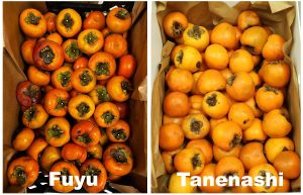From the North Florida Research And Education Center, University of Florida
by Muhammad Shahid
Persimmon harvesting, ripening, and preservation strategies
Persimmons
fruits are renowned for their delicious, sweet taste, making them
incredibly tasty and nutritious. They are native to China but have
spread worldwide, especially in temperate and subtropical climates.
These fruits have been cultivated for thousands of years, primarily for
their sweet flesh, which varies in texture from firm to custard-like,
depending on the variety and level of ripeness. Persimmons are a rich
source of vitamins, particularly vitamins A, C, and E. They also
contain dietary fiber, which is beneficial for digestive health. They
also have anti-inflammatory properties and reduce the risk of chronic
diseases like heart disease and cancer.
Astringent vs non-astringent varieties
There
are two main types of persimmons: the astringent and non-astringent
varieties. Astringent persimmons, like Hachiya and Tanenashi, are high
in tannins and must be fully ripened before consumption to avoid an
unpleasant taste. The water-soluble tannins give the fruit astringency,
making it inedible until it grows soft and ripe. Therefore, ripening
for these varieties is essential to enable the tannins to disintegrate,
allowing the fruit to taste as sweet and rich as it deserves. On the
other hand, non-astringent persimmons, such as Fuyu and Jiro, are
sweeter and can be consumed even when they are still firm. These
varieties have low or no tannin content, and hence, they can be
consumed raw and crispy without the dry mouth effect of other more
stringent types (Figure 1).
 Japanese persimmon fruit: non-astringent variety ‘Fuyu’ (left) and astringent variety ‘Tanenashi’ (right).
Ripening and harvesting the persimmon
Determining
the ripening of persimmons depends on the variety. Astringent varieties
should be completely soft and jelly-like before they are harvested,
while non-astringent varieties can be picked when they are still firm
but have reached their full orange color. Persimmons are typically
harvested by hand to avoid damaging the delicate fruit. Using pruning
shears or scissors, cut the fruit off the tree, retaining a small part
of the stem to prevent skin tearing. This method helps in prolonging
the shelf life of the fruit.
Methods to speed up the ripening process
Cool temperatures:
Keep persimmons cool and leave them in one layer on the countertop.
They will ripen in several days to a week and become ready for
consumption. The indicators include changes in skin color to deep
orange, and the fruit feels almost like jelly when pressed on; it is
prepared to eat. If parts of the fruit are slightly bruised or get
spots, the fruit is still in the ripening process.
Keep persimmon fruit stored with high ethylene fruits:
Ethylene is a natural plant hormone used to promote fruit
ripening. You can quicken the ripening process, especially for
astringent varieties, by harnessing the power of ethylene by placing
the fruit in a brown bag with other fruits like apples or bananas that
produce more ethylene. The enclosed space inside the bag retains
the ethylene gas, enhancing the tannin deterioration in the persimmons.
Use the following steps: Use a clean paper bag, place 3-4 persimmons
with one apple or banana inside the bag, then close it and let it stay
warm. The persimmons should be checked daily in order not to over
ripen. They should soften in 2-3 days, depending on how hard they were.
Freezing:
Freezing is another method to reduce astringency. Freeze the unripe
astringent persimmons for about one day or until you feel they are
already sufficiently chilled. When the fruit thaws, it will have
softened greatly and will not be as astringent because the freezing
helped eliminate tannins. This method does not allow the fruit to ripen
in the usual sense of the word but can quickly turn the persimmons into
a palatable state. When frozen, the fruit becomes soft, slightly brown,
and tender, so this method would be better served if one wanted to use
the persimmon for baking or making purees.
Preservation and storage
Preserving
persimmons is key to enjoying their unique flavor and texture long
after the harvest season. Persimmons, particularly astringent
varieties, have a short shelf life once they ripen, so proper
preservation strategies are essential for extending their usability and
minimizing waste. Here are some practical methods for preserving
persimmons:
• Persimmons should be stored at 50 degrees F (10 degrees C) for optimal preservation
•
Use a transparent plastic bag with holes in it or a container with some
holes on its surface. This will help prevent moisture
accumulation, which, if left for some time, leads to mold growth on the
container walls.
• Do not place persimmons in a tight, covered container, as they require ventilation to prevent mold growth.
•
Use a mesh bag or a basket with a clean cloth that will allow air to
circulate while at the same time keeping the fruit from developing
bruises.
• The refrigerated persimmons can last up to 2 months.
Examine them often for signs of spoilage, such as softness and mold
formation.
• Frozen persimmons can be kept for up to 6 months.
|
|
Bibliography
Shahid, Muhammad. "Persimmon harvesting, ripening, and preservation strategies." North Florida Research And Education Center, UF/NFRED, 17 Oct. 2024, AskIFAS, nwdistrict.ifas.ufl.edu/hort/2024/10/17/persimmon-harvesting-ripening-and-preservation-strategies/.
Accessed 8 Nov. 2024.
Published 8 Nov. 2024 LR
|
